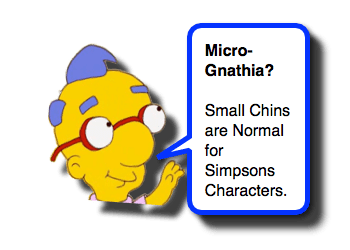Pierre Robin Sequence
 Children with respiratory distress can make even the most confident physician wish that the shift had ended a little sooner. Children with airway anomalies will make that already tight sphincter tone rise to epic levels. One of the most difficult airway cases I ever personally encountered was with a child who had Pierre Robin Sequence and immediately after birth was floppy and blue. No one (not even Peds Anesthesia) could intubate this little one. Fortunately, I was in the NICU and I had a Peds Surgeon immediately available to perform an emergent tracheostomy, but, what would I have done if this child was born in my ED, or I had no immediate access to a surgeon?
Children with respiratory distress can make even the most confident physician wish that the shift had ended a little sooner. Children with airway anomalies will make that already tight sphincter tone rise to epic levels. One of the most difficult airway cases I ever personally encountered was with a child who had Pierre Robin Sequence and immediately after birth was floppy and blue. No one (not even Peds Anesthesia) could intubate this little one. Fortunately, I was in the NICU and I had a Peds Surgeon immediately available to perform an emergent tracheostomy, but, what would I have done if this child was born in my ED, or I had no immediate access to a surgeon?
Pierre Robin Sequence
- Is poorly defined, but generally thought of consisting of:
- Small jaw (micrognathia)
- Posteriorly displaced tongue (glossoptosis)
- Varying degrees of airway obstruction
- May also include cleft palate.
- Respiratory compromise from obstruction is of greatest concern.
- Because the tongue is positioned in the back of the mouth, it tends to block the airway and cause respiratory distress.
- Many will also have feeding difficulties.
Pierre Robin Sequence: What to do
- Mild distress:
- Even the mildest cases are often associated with hypoxia during sleep.
- Placing the child in PRONE position will help (just like with the child with tracheomalacia); gravity will help to keep the tongue out of the airway.
- More significant distress:
- Micrognathia and the posterior tongue can contribute to inadequate face-mask ventilation and make endotracheal intubation difficult (or impossible).
- Don’t forget the Basics!!
- Jaw Thrust (as much as you can)
- Long Nasopharyngeal Airways can help provide ventilation!
- Consider LMA as a bridge to tracheostomy.
- Sometimes the Basics leave you a bit short…
- Transtracheal Ventilation may be the only option you have, so be prepared to do it. (see Transtracheal Ventilation Morsel and Video)
- And don’t be too proud… As soon as you recognize the presence of respiratory distress with the presence of mirognathia, have someone call pediatric anesthesia and pediatric surgery.

